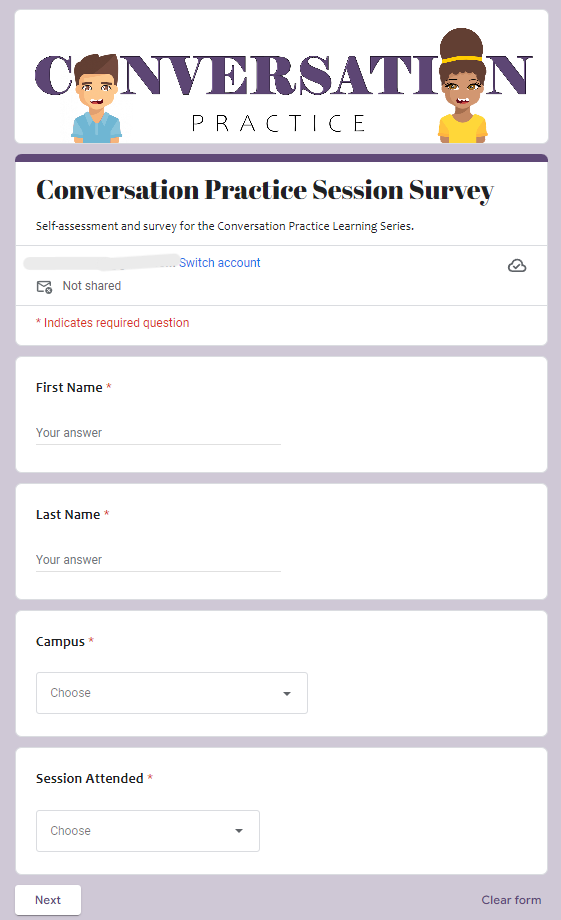Professional Learning Series
Conversation Practice: Strategies to Improve Speaking in Newcomer Emergent Bilingual Students
The Conversation Practice professional learning series aims to equip educators with a range of strategies to enhance conversational and speaking practice for emergent bilingual (EB) students in English Language Arts/Reading (ELAR) classrooms. Through engaging and interactive activities, participants will gain the knowledge and skills to support EB students in building confidence and proficiency in English language communication within a technology-enhanced, project-based learning ELA/R classroom.
*Use the arrows (above – left and right) to view the presentations for the different sessions.*
**Use the controls located at the bottom of the slideshow to navigate through the slide deck.**
Each session in the Conversation Practice PL series will follow a presentation that covers the rationale and purpose of each strategy, as well as opportunities for modeling and practice, a self-evaluation/survey, and more.
Attendees will receive a physical and digital copy of the Conversation Practice Guide, which is a reference sheet that includes a summary of the conversation strategies learned in the course.
EB Campus Contacts and Administrators will track how they deliver the learning session on their campus and how they support, monitor, model, and coach the strategy in their campus’ classrooms using the action plan template to the left.
After each learning session, attendees will assess their own understanding of the content and fill out a survey to provide feedback and feedforward for improving the quality and effectiveness of future learning sessions. Attendees will also have the option to request extra training or support if needed.

More About the Conversation Practice Professional Learning Series
Understanding by Design Framework for Conversation Practice Professional Learning Series
Topic: Conversation Practice: Strategies to Improve Speaking for Newcomer Emergent Bilingual Students
Strategies Covered: Dialogues, 3 – 2 – 1, Ask – Answer – Add, and Video.
Rationale: Due to continued declines in performance in emergent bilingual (EB) students’ performance on the Speaking domain of the Texas English Language Proficiency Assessment System (TELPAS), school administrators and emergent bilingual (EB) specialists in my district voted to prioritize professional learning that focuses on speaking initially, and then moves on to the other domains of literacy.
Audience: The audience is a group of campus-based EB specialists and administrators who will then take the information back to their campuses and train the teachers who work with newcomer emergent bilingual students. The trainers have background knowledge and experience in teaching English language learners and want to learn more/specific strategies that meet the needs of newcomer EB students.
Needs: The campus trainers need to learn how to use the conversation strategies effectively to support the oral language development and academic achievement of newcomer emergent bilingual students. They also need to learn how to model, coach, and provide feedback to the teachers who will implement the strategies in their classrooms.
Schedule/Timeline: The professional learning (trainer of trainer sessions) will consist of four sessions, each lasting one hour, with a total of 4 hours of contact time. The sessions will be spaced out over eight weeks, with one session every other week, to allow time for reflection and application between sessions. There will be an additional review and reflection week to close out the learning series for a total of nine weeks (with the aim of coinciding with the marking period).
Note: Campus specialists and administrators will have 1 – 2 days to turn the training around to teachers on their campus during PLCs and 8 – 9 school days to monitor implementation, model, coach, and provide feedback to teachers per conversation strategy.
Location: The sessions will be in-person during campus contact meetings.
Resources: The main resource for the professional learning will be the book “The ELL Teacher’s Toolbox: Hundreds of Practical Ideas to Support Your Students” by Larry Ferlazzo and Katie Hull Sypnieski. The book contains detailed explanations and examples of the conversation strategies, as well as many other useful tips and tools for teaching English language learners (teachers and each campus representative have received a copy of this book). The campus trainers will also need access to a computer, internet connection, and writing materials. They will also be provided with digital documents/hard copies of session deliverables to record their takeaways, reflections and plans.
To enhance the quality and impact of the learning experience, the Conversation Practice professional learning series was designed using the Five Principles of Effective Professional Learning: duration, support, active participation, modeling, and relevant content.
The PL series lasts for eight weeks, which enables deep learning and application of the conversation/speaking strategies by both teachers and students. It also offers continuous support and feedback from peers and coaches to encourage collaboration and reflection. Moreover, the learners are engaged in various activities and scenarios that allow them to practice and improve their skills. Furthermore, it demonstrates the effective use of the conversation strategies through examples and modeling from specialists, coaches, and administrators. Finally, the Conversation Practice learning series aligns with the current roles and needs of the learners, as well as the goals and standards of the district.
References
Ferlazzo, L., & Hull-Sypnieski, K. (2018). The ELL teacher’s toolbox: hundreds of practical ideas to support your students. Jossey-Bass.
Gulamhussein, A. (2013, September). Teaching the teachers effective professional development in an era of high stakes accountability. Center for Public Education. Retrieved October 20, 2023, from http://www.centerforpubliceducation.org/system/files/2013-176_ProfessionalDevelopment.pdf
Wiggins, G., & McTighe, J. (2005). Understanding by design (2nd ed.). Association for Supervision and Curriculum Development.